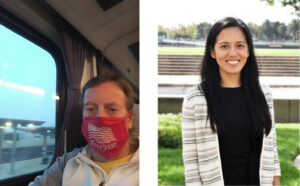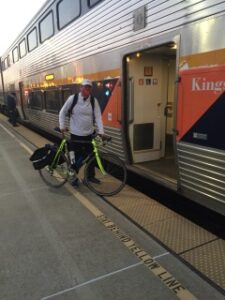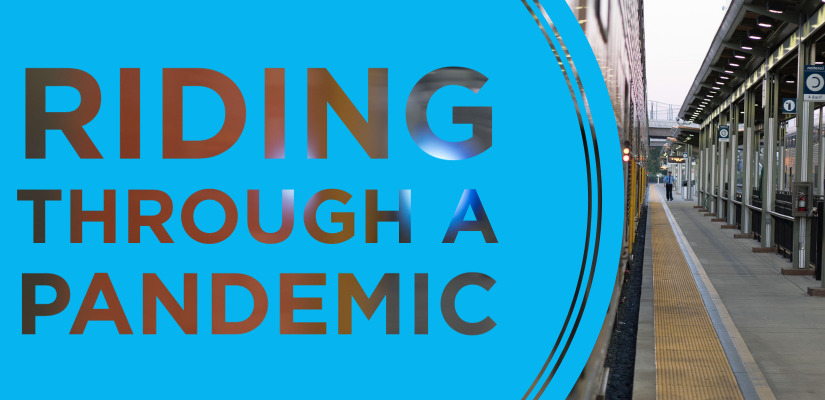Throughout the pandemic and the various travel restrictions that have come along with it, the Capitol Corridor has continued to run as an essential service throughout Northern California. Much of what has been published about our service since COVID-19 came into our lives is that ridership is down, hovering at just 11-15% of normal ridership. You may wonder, who are the people that make up that small percentage of riders who continue to travel with us? And what is it like riding the Capitol Corridor during a pandemic?
We had an opportunity to speak with a couple Capitol Corridor riders and discuss their recent experience on board the train, how the coronavirus has impacted their travel, health and safety concerns, and why—in spite of a world-wide pandemic—they continue to ride the train.
Meet Our Riders: Jim A. and Kathrina G.

Jim’s initial ride with us goes back 15 to 20 years and, over time, has evolved into a five-day a week, round-trip schedule between Roseville and Davis. His one hour and 25-minute commute does come with a first- and last-mile challenge, which he has resolved by incorporating his bike into his train trip rather than simply hopping into the car. “It’s a lower stress option and much safer than driving.”
Kathrina is a newcomer to our service, with just a little over three months of time spent riding the train. Taking on a new job in Suisun City also meant a new commute from the Sacramento area. Her initial plan was to drive, however, after colleagues with a similar commute highly recommended she take the train on Friday’s to avoid the traffic from Suisun City to Sacramento, which gets really backed up, especially in the causeway by Davis.
And so, she explained “I was considering just using the Capitol Corridor on Friday’s. After that first ride, I tried going back to driving but I was just exhausted by the time I got to work.” Since using the train, Kathrina hasn’t looked back. In fact, she found that “the Capitol Corridor is very modern, super comfortable. What I experienced exceeded my expectation.”
COVID-19 Impact
The Capitol Corridor was Kathrina’s first introduction to riding the train, which, with her tenure of less than a year, meant she began riding during the pandemic. “I had some hesitation and was feeling trepidation about riding the train given that it was advised not to be around people,” she explained. “So that was my big concern when it was suggested to me. Is it going to be safe for me to use this mode of transportation? I was assured that it was super safe, and that the Capitol Corridor does a really good job cleaning the train and that ridership is down so you can maintain adequate social distancing. That was immediately reassuring. There was nothing to be concerned about.”
Back in March 2020, as the Bay Area began to roll out shelter-in-place orders, the Capitol Corridor quickly went to a reduced schedule, impacting veteran riders, like Jim. With the train connection suspended between Auburn and Sacramento, Jim had to leave an hour earlier from home to catch the bus in Roseville and then the train in Sacramento. And on the way home, it was another hour later at night. “I was working two days a week in the office during that time, so it wasn’t too bad. That was the biggest disruption, because of the modified schedule, but now that’s no longer the case.” In June 2020, service increased, and the Auburn to Sacramento connection was restored.
For anyone who is curious about the health or safety of riding the train during the pandemic, Jim has few worries, “there’s plenty of room to distance, and everyone wears a mask. So, there’s no real concerns.” Similarly, Kathrina shared, “I think the COVID concern, no matter where I am, is going to be a concern in the back of my mind. There have been a lot of articles that have demonstrated that the hot spots almost never occur on public transit. That has given me a sense of comfort, that and from my own personal experience seeing the train be very clean and everyone wearing masks.”
As part of its COVID-19 health and safety protocols, the Capitol Corridor requires all passengers to wear a face covering and maintain social distance from fellow riders. One of the service’s most popular amenities, the Café Car, has also been suspended. With all these changes, you might wonder if it’s still the same experience. For Jim, who’s back to riding five days a week, “the only difference is that the ridership isn’t there right now and the Café Car is closed. It’s a different experience, but still worth it to use the service.”
Why They Ride?

In addition to the environmental benefits of riding the train, there are other tangible aspects that keep riders like Kathrina and Jim coming back “By taking the train, you can get work done, stare out the window, or do other things, and that’s really nice,” said Kathrina. “And then there’s also the convenience and the comfort factor, as well as the fact that trains run on time.”
Our long-time rider Jim has been able to take in all of that and more, sharing that “between the passengers and conductors, there’s a kind of a camaraderie that’s generated. And I think the whole package is a real vital resource for the I-80 corridor and connections in between, like Placer and Sacramento into the Bay Area.”
This interview has been edited and condensed for clarity.

